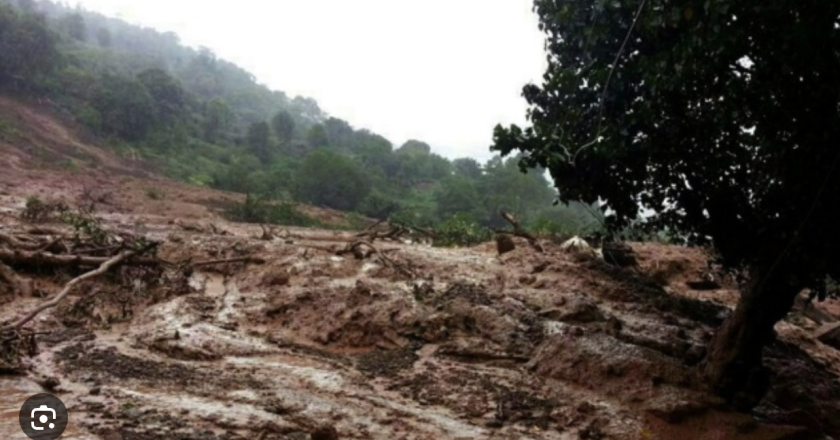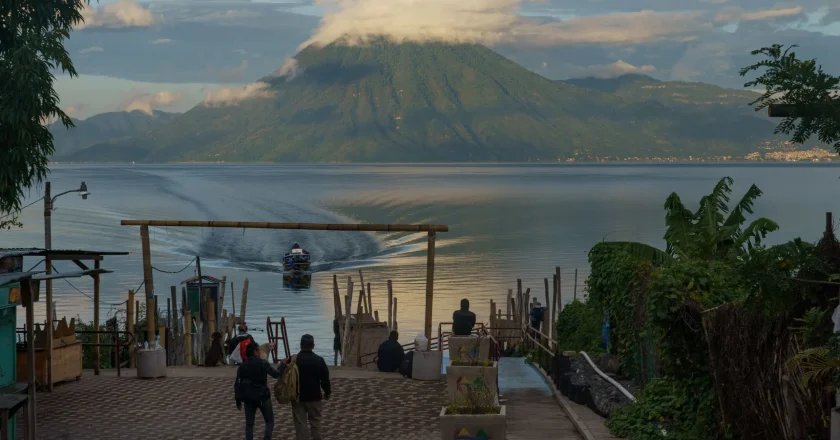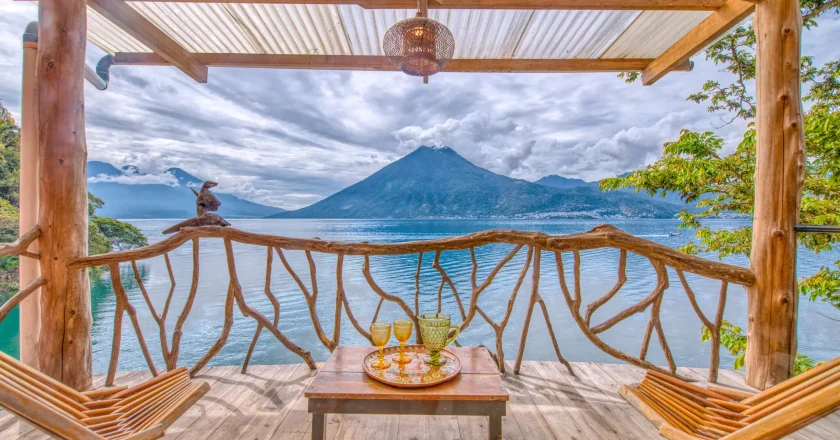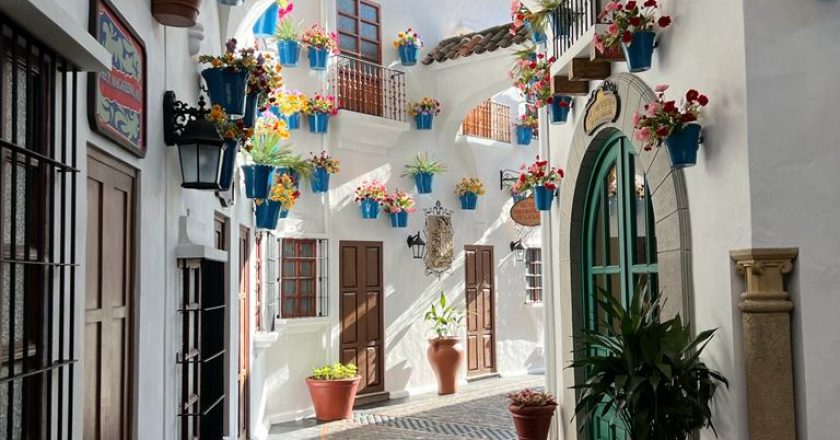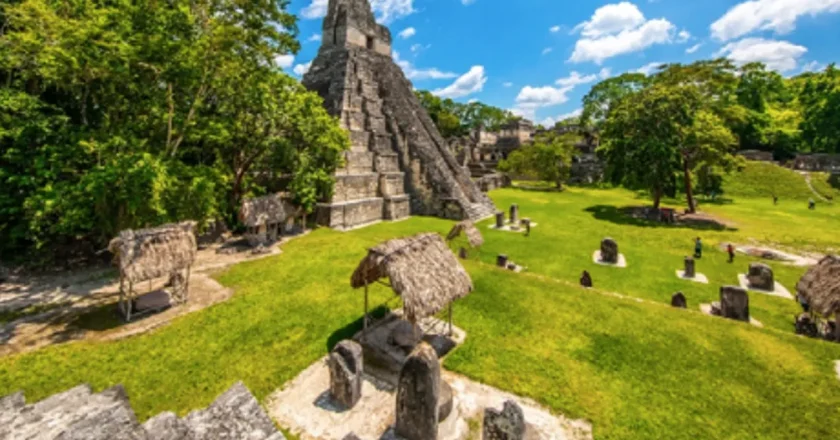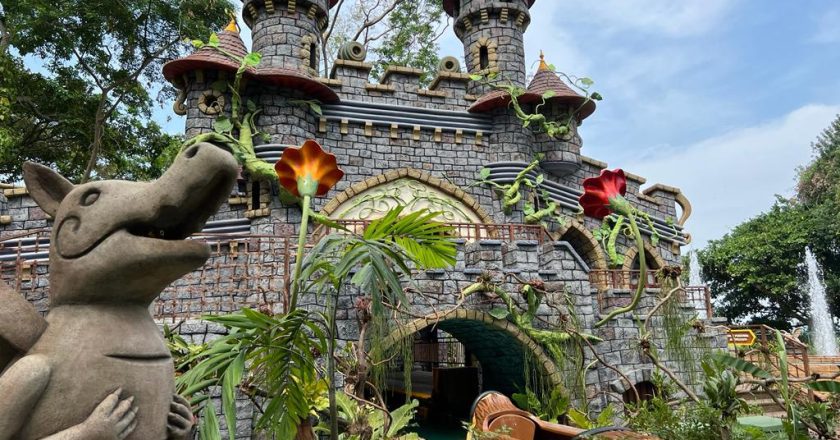“These days, my role as an innkeeper occupies me almost as much as fiction,” writes Joyce Maynard, who, during the pandemic, hired locals in a Guatemalan village to turn her writing retreat into a guesthouse.
It’s close to midnight, two weeks into a precious writing residency in New Hampshire where I have come to finish a novel. My telephone rings.
From Lake Atitlán, Guatemala, a few thousand miles away, comes the voice of a woman I’ve never met: “I left the key to my casita on the bed. Can someone let me back in?”
I’ll get right on it, I tell her. A few hours earlier, I had spent an hour on the phone with a plumber discussing the installation of a new Jacuzzi and ordering wood for the sauna. The day before, I had arranged for a guide to take two guests on a hike to see the sun rise above the volcanoes, and the day before that, an airport pickup for a family of five from Indiana, and dinner on the terrace for a couple from Germany celebrating their honeymoon.
With my property manager out sick, the past few days have been busier than usual, but it’s a rare day in which I don’t find myself occupied with at least one guest staying at the modest place I’d bought 23 years ago as a refuge for writing. It now includes two houses, four casitas, two docks, a fleet of kayaks, a sauna, a yoga platform, a waterfall and a pizza oven.
I’ve been a writer all my life. But these days, my role as an innkeeper occupies me almost as much as fiction. I never intended this, but introducing travelers from all over the world — particularly those from the United States, the country of my birth, whose State Department website has posted warnings about travel to Guatemala for years — has become a central concern of my life.
‘It was my private little oasis’
My history in Central America began more than 50 years ago, at age 11, when my mother took my sister and me on a six-week sojourn on buses and a train from the Texas border to San Cristóbal de las Casas in the Mexican state of Chiapas. My experience of Indigenous culture that summer opened up my world.
A decade later, I was invited to join an orchid hunt in the highlands of Guatemala. Never mind that a civil war was going on.
Our slashed tires didn’t keep me from falling in love with the country — most particularly, the 50 square miles of turquoise Lake Atitlán, and the people who made their homes there, who still dressed in traditional Guatemalan clothing made from hand-woven cloth, cultivated maize on the hillsides and followed the Mayan calendar.
I vowed then that I’d return to the lake, though years passed before I did. By then, I’d raised three children and watched them head off for adventures of their own. For $250 a month, I rented a little house on the shores of the lake, signed up for salsa lessons and Spanish school, wrote a novel and experienced a greater sense of well-being than I’d known in years.
I lived alone. I had no phone. There was no internet, so every few weeks I took a boat across the lake to look at my email. At the end of my writing day, I brought my shopping basket to the market to buy vegetables for that night’s dinner. Every morning, I swam a half mile in the lake.
It was on one of my swims that I spotted a sign on the shore: Se Vende. For Sale. The land was wild and steep, covered in brush, with a small adobe house. A dozen species of birds I’d never seen perched in the trees. Across the water stood one of the five volcanoes that encircle the lake.
These were days when a person of limited means could still borrow against her home, which was how I came up with the $85,000 to buy roughly three acres of land on the shores of one of the most beautiful lakes on the planet.
I named the place Casa Paloma. A few times a year, I traveled there to write and swim. It was my private little oasis.
With the help of two young men from the village, Miguel and Mateo, I built a garden, with retaining walls and stone paths winding up the steep hillside. Over the years, the fruit trees we planted matured, and roses bloomed — also orchids, Thunbergia vines, figs, pomegranates, bananas.
I finished half a dozen novels in that house. Every afternoon, I carried a bowl of popcorn down to my dock for the children who came to swim there, and every morning, I greeted the fisherman who showed up in the little bay in front of my house without fail to harvest crabs just as the sun came up behind the volcano.
Having recognized early on that this was a place offering inspiration and peace, I started a writing workshop, hosting a small group of women for a week every winter. For $35 a night, they stayed at a simple hotel in the village but gathered at Casa Paloma every day to work on their manuscripts.
Much changed over those years. A hurricane hit, causing a landslide. Travelers arrived in greater numbers, along with storefronts advertising healers, yoga teachers and shamans (cranial sacral massage, sound healing, a place known as the Fungi Academy). I added on to my house, planted more flowers, built a temazcal — a Mayan sauna — and a little guesthouse where I set up my writing desk. Back in California, I fell in love with my second husband, Jim, and introduced him to the lake. The fact that we were in our 50s now didn’t stop us from climbing the volcano together.
The year after we married, Jim was diagnosed with pancreatic cancer. The two of us traveled to the lake together for what turned out to be his last winter. After he died, I returned alone. Many times over the years, I’d found solace in those waters. Now I did again.
The pandemic strikes
I had scheduled my memoir workshop for March 2020, the month the pandemic struck the United States. As always, I’d booked a dozen rooms for my writing students in a small village hotel. Though coronavirus had not been reported in Guatemala, I was uncertain whether anyone would show up, but 16 women traveled there.
Two days later, the president of Guatemala announced that the airport was closing, and eight women flew home. Eight stayed on — making do with meals of rice and beans and guacamole, and plenty of wine.
Twelve days later, the State Department provided a plane to take U.S. citizens home. But I decided to remain, and invited two of the women from the workshop, Jenny and Xiren, to stay with me for a few weeks.
In the end, we stayed for six months — Casa Paloma, we realized, was probably the best place to be. People in the village appeared blessedly free of Covid. But another issue plagued them: With all tourists gone, they had no way of supporting their families.
Some of the expats in town took up a collection to help. I had lived in this place long enough to know what the community needed more: jobs. So I embarked on the project of building a guesthouse.
Every day, a crew of about 20 men made their way down the hillside with their picks and shovels, bags of cement or stones on their backs. Every morning, just as the sun was coming up, they greeted Jenny, Xiren and me as we sat at our laptops.
Sometimes a harpoon fisherman stopped by with a fish he’d caught 10 minutes before. That would be dinner, eaten by candlelight.
In the months that followed, I kept coming up with building projects. Five more casitas, each one different. One featured stone walls with hand-carved stone heads built into them, made by a man in the village. In one we built a high wall using the old methods of adobe construction. I bought a chair made by a local craftsman, carved out of a single massive avocado tree. He carried it on his back the mile or so from his home.
I am not a wealthy woman. In California, I could never have employed a crew for 18 months. As it was, paying the men a good local wage stretched me to my limits. But I knew this: When you gave a person a job in this village, a family of 10 would eat that night.
The men did beautiful work. Sometimes, checking in with them at the end of the day, I’d discover some detail — a spiral of tiny snail shells cemented into a shower wall, a broken ceramic monkey attached to a twisted piece of wood, with bougainvillea spilling from its head and silver paper from a chocolate bar wrapper for eyes. Miguel and Mateo trained plants to grow in the shapes of a giraffe, a llama, a rabbit and a heart. A carpenter named Bartolo built me a table of conacaste wood in the style of one I found on Pinterest that was designed by the woodworker George Nakashima.
Our days and weeks took on a rhythm. Every morning, as I made my way up the hill to my writing desk with my laptop and my coffee, I’d greet the crew of men coming down. As I sat at my desk, I’d hear the steady beat of the men’s hammers, the sound of rocks emptying from buckets.
It came to me that in all my years of writing books — almost half a century — I’d never known such an immediate connection between the stories I made up in my head and the world of physical labor. When the men and I called out our greetings every morning, we knew that each of us had a job to do. The one supported the other.
By the following winter, just over a year from when the world had shut down, with vaccines available at last, we welcomed 12 writing students. This time, they could stay on my property in the five new houses the men had built, sharing meals on the expanded veranda, looking out at the lake, with meals prepared by our local chef, Rosa.
I’m a writer, not a businesswoman. It came to me that if a person empties her bank account to build a property for 16 guests that requires a crew of more than 20 people to maintain it, the place cannot sit empty. And that is how I came to be the host of a hotel and retreat center.
With the time and thought I’ve devoted to building Casa Paloma, I probably could have written a few more books. The casitas bear the names of some I have written: “To Die For,” “At Home in the World,” “Count the Ways.” One, Casa Una, is named for my newest granddaughter. Over the last year, my team, made up almost entirely now of local men and women, has hosted more than 300 groups of guests — yoga practitioners, hikers intent on tackling the volcano, couples celebrating a honeymoon, families bringing children they had adopted years ago to the country of their birth for the first time. This past high season, we were booked almost every night.
Looking back
Back in 2020 — that stretch of months when it felt as though the world stood still — I experienced a state of such unprecedented concentration that I was able to finish a novel.
So — with the men still working — I started another novel about a woman from the United States who, in the aftermath of a personal tragedy, lands in a small village on the shores of a lake surrounded by volcanoes, in an unnamed Central American country. She finds herself unexpectedly running a magical hotel surrounded by orchids and birds.
At the time, I believed that what I was writing was a work of pure fiction, almost a fairy tale. It was a full year later that the thought occurred to me: I’d built a hotel, myself. Now I’d better figure out how to run one. And I did.
The pandemic strikes
I had scheduled my memoir workshop for March 2020, the month the pandemic struck the United States. As always, I’d booked a dozen rooms for my writing students in a small village hotel. Though coronavirus had not been reported in Guatemala, I was uncertain whether anyone would show up, but 16 women traveled there.
Two days later, the president of Guatemala announced that the airport was closing, and eight women flew home. Eight stayed on — making do with meals of rice and beans and guacamole, and plenty of wine.
Twelve days later, the State Department provided a plane to take U.S. citizens home. But I decided to remain, and invited two of the women from the workshop, Jenny and Xiren, to stay with me for a few weeks.
In the end, we stayed for six months — Casa Paloma, we realized, was probably the best place to be. People in the village appeared blessedly free of Covid. But another issue plagued them: With all tourists gone, they had no way of supporting their families.
Some of the expats in town took up a collection to help. I had lived in this place long enough to know what the community needed more: jobs. So I embarked on the project of building a guesthouse.
Every day, a crew of about 20 men made their way down the hillside with their picks and shovels, bags of cement or stones on their backs. Every morning, just as the sun was coming up, they greeted Jenny, Xiren and me as we sat at our laptops.
Sometimes a harpoon fisherman stopped by with a fish he’d caught 10 minutes before. That would be dinner, eaten by candlelight.
In the months that followed, I kept coming up with building projects. Five more casitas, each one different. One featured stone walls with hand-carved stone heads built into them, made by a man in the village. In one we built a high wall using the old methods of adobe construction. I bought a chair made by a local craftsman, carved out of a single massive avocado tree. He carried it on his back the mile or so from his home.
I am not a wealthy woman. In California, I could never have employed a crew for 18 months. As it was, paying the men a good local wage stretched me to my limits. But I knew this: When you gave a person a job in this village, a family of 10 would eat that night.
The men did beautiful work. Sometimes, checking in with them at the end of the day, I’d discover some detail — a spiral of tiny snail shells cemented into a shower wall, a broken ceramic monkey attached to a twisted piece of wood, with bougainvillea spilling from its head and silver paper from a chocolate bar wrapper for eyes. Miguel and Mateo trained plants to grow in the shapes of a giraffe, a llama, a rabbit and a heart. A carpenter named Bartolo built me a table of conacaste wood in the style of one I found on Pinterest that was designed by the woodworker George Nakashima.
Our days and weeks took on a rhythm. Every morning, as I made my way up the hill to my writing desk with my laptop and my coffee, I’d greet the crew of men coming down. As I sat at my desk, I’d hear the steady beat of the men’s hammers, the sound of rocks emptying from buckets.
It came to me that in all my years of writing books — almost half a century — I’d never known such an immediate connection between the stories I made up in my head and the world of physical labor. When the men and I called out our greetings every morning, we knew that each of us had a job to do. The one supported the other.
By the following winter, just over a year from when the world had shut down, with vaccines available at last, we welcomed 12 writing students. This time, they could stay on my property in the five new houses the men had built, sharing meals on the expanded veranda, looking out at the lake, with meals prepared by our local chef, Rosa.
I’m a writer, not a businesswoman. It came to me that if a person empties her bank account to build a property for 16 guests that requires a crew of more than 20 people to maintain it, the place cannot sit empty. And that is how I came to be the host of a hotel and retreat center.
With the time and thought I’ve devoted to building Casa Paloma, I probably could have written a few more books. The casitas bear the names of some I have written: “To Die For,” “At Home in the World,” “Count the Ways.” One, Casa Una, is named for my newest granddaughter. Over the last year, my team, made up almost entirely now of local men and women, has hosted more than 300 groups of guests — yoga practitioners, hikers intent on tackling the volcano, couples celebrating a honeymoon, families bringing children they had adopted years ago to the country of their birth for the first time. This past high season, we were booked almost every night.
Looking back
Back in 2020 — that stretch of months when it felt as though the world stood still — I experienced a state of such unprecedented concentration that I was able to finish a novel.
So — with the men still working — I started another novel about a woman from the United States who, in the aftermath of a personal tragedy, lands in a small village on the shores of a lake surrounded by volcanoes, in an unnamed Central American country. She finds herself unexpectedly running a magical hotel surrounded by orchids and birds.
At the time, I believed that what I was writing was a work of pure fiction, almost a fairy tale. It was a full year later that the thought occurred to me: I’d built a hotel, myself. Now I’d better figure out how to run one. And I did.


